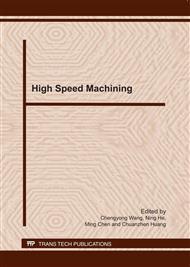p.26
p.32
p.38
p.43
p.49
p.55
p.61
p.67
p.73
Friction and Wear Properties of WC-Co Cemented Carbide Sliding against Ti6Al4V Alloy in Nitrogen Gas
Abstract:
Titanium alloys are known for their strong chemical reactivity with surrounding gas due to their high chemical affinity, especially in dry machining. But it is very difficult to study the influence of surrounding gas on the tool-workpiece interface because of the machining processes’ complexity. In this paper, rotating pin-on-disc friction tests have been carried out at room temperature in ambient air and nitrogen gas to investigate the friction and wear behavior of WC-Co cemented carbide sliding against Ti6Al4V alloy. Scanning electron microscope (SEM) and Energy dispersive x-ray spectroscopy (EDX) have been used to examine the worn surface of the WC-Co pin and Ti6Al4V disc. The result shows that, compared to air, nitrogen gas brings a slight decrease in coefficient of friction, but a significant deduction in wear of the pin and disc. The SEM observation and EDX analysis indicate a distinct difference in wear mechanism between the pin and disc. Severe grooved wear, squeezing, adhering and tearing interactions are the main mechanisms causing the extensive wear of Ti6Al4V disc. Abrasion, adhesion and “pulling out” are the main mechanisms resulting in the wear of WC-Co pin.
Info:
Periodical:
Pages:
49-54
Citation:
Online since:
March 2011
Keywords:
Price:
Сopyright:
© 2011 Trans Tech Publications Ltd. All Rights Reserved
Share:
Citation:


